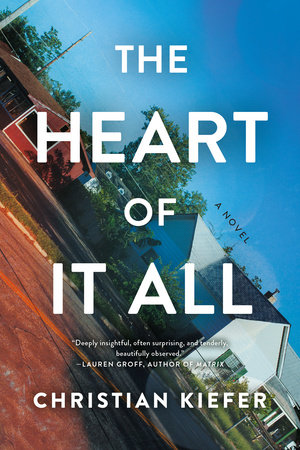The Heart of It All: A Novel
- By Christian Kiefer
- Melville House
- 368 pp.
- Reviewed by Anne Eliot Feldman
- October 6, 2023
A poignant tale of small-town Ohioans struggling to preserve the best in themselves.

“Death brought casseroles and Tom took them, every one, his hands numb upon the square containers, many warm from the oven, others cold so that their foiled tops wept with moisture. There was nothing to be done but stand and nod and thank people for coming.” So writes Christian Kiefer at the very beginning of his unforgettable The Heart of It All, a tale of plainspoken people living out intertwined lives in a small Ohio town that’s as true and honest a reflection of our times as you’ll find.
The novel’s large ensemble cast is anchored by Tom and Sarah Bailey, who are processing an unimaginable loss. Deeply rooted in the area and a friend to many, Tom grapples with the enormity of his grief. With no less vibrancy, however, the author points the spotlight on three other families with their own complicated lives. Khalid and Rafia Marwat have emigrated from Pakistan with their two teens. Khalid owns the electronics factory that employs Tom and many others. Another factory worker, Mary Lou Miller, shares a cramped apartment with her verbally abusive and aging mother. Detroit expat Anthony Shaw, meanwhile, has come to live with his aunt Paula because his drug-addicted mother can no longer support him.
Kiefer’s expertly drawn characters rarely lose sight of “the fierce terror of life’s essential fragility, not only brittle but actively aflame.” While most are “surviving paycheck to paycheck, on loan, on credit, on faith,” it is their human frailties that move us to the core. Mary Lou wonders if the career path she chose might’ve been far less ambitious than she was capable of achieving. She and others like her put in long hours at tedious jobs they hate but need. Anthony’s hyper-awareness of being a 19-year-old Black man in an all-white community is palpable when he takes an innocent stroll at night while Tom’s daughter, Janey, walks nearby. Tom and Sarah, for their part, persist in a difficult marriage.
The unnamed Rust Belt town reflects their collective despair. It is “a haggard place, once a center of modest industry but that time is a century gone.” At the local high school, MAKE AMERICA GREAT AGAIN placards from last year’s presidential election still hang. Among the beautiful Queen Anne, Greek revival, and neoclassical homes from another era, what dominates the view these days are the places where most of the struggling population resides:
“[in] homes of no description at all: peak-roofed boxes with railed patios, storm doors rattling…All of this amidst the darkness of meltwater stains, missing shingles patched with plywood or plastic sheeting, broken windowglass with duct-taped cardboard, between which are those who are just able to maintain and repair and hold together the tenuous shamble of their lives. Dead lawns mowed clean to bare bristle.”
Yet amid so many fears and inadequacies, Kiefer shines a ray of hope. Maybe you can’t afford that new car, and perhaps there’s no better job in sight, but you can enjoy some laughs with friends at the bowling alley. Somebody makes the effort to bring over a frozen pizza, and it’s not the food but the gesture that helps you hold your head higher. And there’s the universal hope, however slim, for a better future. Kiefer gives a nod to this “circle of life” persistence here, when Khalid contemplates the interplay of three generations of his family:
“That he [himself] had once been Rashid’s age was difficult to fathom. That his father had was impossible. And yet here they were, the cloth of their own imaginings, the old man into whose shape both Khalid and Rashid would one day find themselves and the boy from which Khalid and his father had come…How beautiful his son looked. How beautiful was his life.”
Yes, hope is faint in this town, but we watch it endure nonetheless. And when we close this book, we remember it. Because when there is no energy left, no promise in sight, people still reach out for each other, to help and to connect. In the end, The Heart of It All is all heart.
With a B.A. from Colgate University, an M.A. from Georgetown University, both in Russian area studies, and a UCLA certificate in fiction writing, Anne Eliot Feldman has worked in the Library of Congress and the defense industry. She’s completing her own debut novel, about the heart-stopping fragility of cacao beans and true love.

